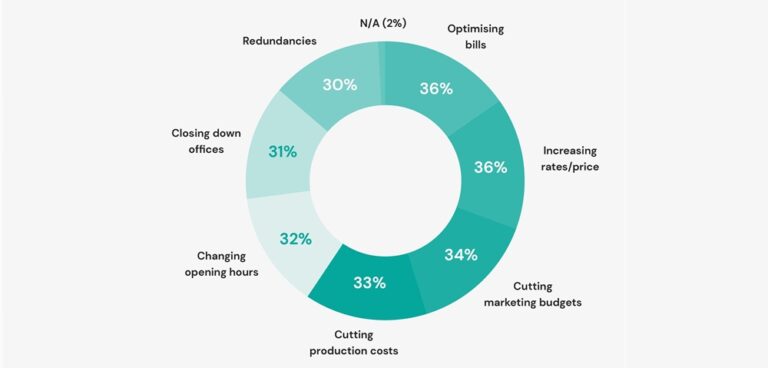As labour, services, and material costs rise, many businesses are seeking ways to reduce expenses in 2024.
Each month, an average of 7,520 online searches on Google are made for terms related to cost-cutting in business, such as “How to cut costs in business?” and “Business cost-cutting strategies”.
A recent SME insights report by Dojo, who specialise in payments for enterprise and independent businesses, sheds light on the challenges faced by UK small and medium-sized enterprises.
Dojo surveyed 1,001 SME owners, revealing the seven most common cost-cutting measures that businesses have implemented this year, as well as the industries that are focusing on each the most.
The study reveals that an estimated 5.4 million SMEs* have had to cut costs in 2024.
Top Cost-Cutting Measures
|
Ranking |
Cost cutting measure |
Overall percentage |
Industry utilising the method most |
Industry-specific percentage |
|
1 |
Optimising bills (energy etc) |
36% |
Arts & Culture |
45% |
|
2 |
Increasing rates/price |
36% |
Arts & Culture |
54% |
|
3 |
Cutting marketing budgets |
34% |
Finance |
45% |
|
4 |
Cutting production costs |
33% |
Retail, catering & Leisure |
42% |
|
5 |
Changing opening hours (e.g. closing earlier, opening later, only opening on certain days) |
32% |
Manufacturing & Utilities |
41% |
|
6 |
Closing down offices |
31% |
Architecture, Engineering & Building |
39% |
|
7 |
Redundancies |
30% |
Sales, Media & Marketing |
37% |
36% of businesses have focused on optimising their bills this year to reduce their expenses. The Arts & Culture sector utilised this method most, with 45% of businesses in this industry saying they had optimised bills to save money.
36% of businesses have taken the approach of increasing rates/ prices this year to cut costs. Over half of businesses (54%) in the Arts and Culture sector have implemented increased rates and prices. This method has been utilised most across businesses with a turnover of under £100,000, where half (50%) have increased their rates/ prices.
34% of businesses have cut their marketing budgets this year. The sector that has utilised this method the most is Finance, with 45% of businesses in this industry cutting marketing budgets. For businesses that turnover £100K to £999,999 a year, 40% have said they are cutting marketing budgets this year – the highest out of all SMEs surveyed.
33% of SMEs have cut their production costs in 2024. This is most common across the retail, catering & leisure sectors, where 42% have focused on cutting production costs the most this year. Business owners that turnover £50 to £99.99 million are utilising this method the most, at 41%.
Dojos research found that 32% of businesses have adjusted their opening hours this year. Businesses within the Manufacturing & Utilities industries are doing this more than any other industry (41%) and this is the most common across businesses with a turnover of £500 million and above (41%).
Closing down offices can lead to significant cost savings on rent, utilities, and other overhead expenses, as 31% of SMEs have done or are considering doing this year. Architecture, Engineering & Building is the industry closing down the most offices, with 41% utilising this method to cut costs. The UK city with the most office closures is Southampton, where 39% of businesses have taken this approach. Plymouth is the UK city where the least businesses have closed down offices, at just 9%.
30% of businesses have made redundancies to cut costs, and Dojo’s data found that the sales, media and marketing industries implemented the most redundancies at 37%. 42% of businesses with a turnover of £500 million have made redundancies, which is the most out of all company sizes.
You can find the full study here.


